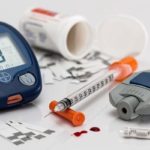1. For patients newly diagnosed with type 2 diabetes, weight loss achieved through early dietary intervention was strongly associated with lower HbA1c at 0–6 months
2. Increases in “carb/fat balance” dietary pattern were associated with improvements in HbA1c at 6 months independent of weight loss
Evidence Rating Level: 1 (Excellent)
Study Rundown: Diet is a mainstay of treatment for patients diagnosed with type 2 diabetes mellitus (T2DM). Nutritional guidelines for glycemic management focus on individualized recommendations rather than specifying a “one-size-fits-all” approach. Improved HbA1c concentrations are consistently associated with weight loss achieved by dietary changes. However, it is unclear if various dietary patterns can benefit glycemic control in ways beyond their effect on bodyweight. This randomized controlled trial, called the Early-ACTivity-In-Diabetes trial, aimed to assess whether changes in dietary patterns altered glycemic control independently of effects on bodyweight in newly diagnosed T2DM. A total of 593 adults diagnosed in the previous 5-8 months with T2DM were recruited from December 2005 to September 2008 within South-West England. Participants were randomized to either a usual care, dietary intervention or diet and physical activity intervention group. During the first 6 months of the study, glucose-lowering medications were not changed. Trial endpoints were HbA1c and blood pressure at 6 months (primary) and 12 months (secondary) post-intervention. Over 6 months, reductions were observed in mean bodyweight (− 2.3 (95% CI: − 2.7, − 1.8) kg), body mass index (− 0.8 (− 0.9, − 0.6) kg/m2), energy intake (− 788 (− 953, − 624) kJ/day), and HbA1c (− 1.6 (− 2.6, -0.6) mmol/mol). Weight loss was strongly associated with lower HbA1c at 0–6 months (β = − 0.70 [95% CI − 0.95, − 0.45] mmol/mol/kg lost). Increases in “carb/fat balance” dietary pattern (characterized by more consumption of fresh fruit and low-fat milk and less consumption of red meat and butter/animal fats) were associated with improvements in HbA1c at 6 months independent of weight loss (β = − 1.54 [− 2.96, − 0.13] mmol/mol/SD). Promoting weight loss should remain the primary nutritional strategy for improving glycemic control in early T2DM. However, improving dietary patterns that result in an increase in carb/fat balance may provide additional improvements in glycemic control.
Click here to read the study in BMC Medicine
Relevant Reading: Dietary patterns and type 2 diabetes: A systematic literature review and meta-analysis of prospective studies
In-Depth [Randomized Controlled Trial]: The Early ACTID trial, a 12-month, multi-centre, parallel-group randomized controlled trial, recruited 593 adult participants from South-West England and randomly assigned them to one of three groups, namely usual care, dietary intervention, or diet and physical activity intervention. Usual care consisted of standard dietary and exercise advice at 0 and 12 months, with an interim review by study doctors and nurses at 6 months, where no further advice was given. The diet intervention aimed to enable and maintain 5–10% weight loss through a non-prescriptive dietary intervention based on a number of UK guidelines. Specifically, participants were encouraged to consume starchy carbohydrates and choose higher-fiber/wholegrain options, reduce added sugars, increase oily fish and reduce fatty and processed meat intakes. Dietitians met with participants at randomization and every 3-4 months, with study nurses reinforcing advice every 6 weeks. The diet and physical activity intervention consisted of the same dietary intervention as the diet-only group, in addition to an ≥ 30 min walk on ≥ 5 days per week. Diet was self-reported using 4-day food diaries. At baseline, a ‘carb/fat balance’ dietary pattern and an ‘obesogenic’ dietary pattern were derived using reduced-rank regression, based on hypothesized nutrient-mediated mechanisms linking dietary intake to glycaemia directly or via obesity. Relationships between 0 and 6 month change in dietary pattern scores and baseline-adjusted HbA1c at 6 months (n = 242; primary outcome) were assessed using multivariable linear regression. Models were repeated for periods 6–12 months and 0–12 months (n = 194 and n = 214 respectively; secondary outcomes). At baseline, 593 participants were included. Additionally, two dietary patterns, a “carb/fat balance” dietary pattern (characterized by higher percentage energy from starches and sugars and lower percentage energy from fats) and an “obesogenic” dietary pattern (characterized by an energy-dense, higher-fat, lower-fiber diet), were identified. Average weight, body mass index (BMI), total energy intake (TEI), and HbA1c all reduced during 0–6 m (mean change: − 2.3 (95% CI: − 2.7, − 1.8) kg; − 0.8 (− 0.9, − 0.6) kg/m2; − 788 (− 953, − 624) kJ; − 1.6 (− 2.6, − 0.6) mmol/mol [− 0.15 (− 0.24, − 0.06) %]). There was strong evidence that increases in ‘carb/fat balance’ dietary pattern scores were associated with reductions in HbA1c between 0 and 6 m (model 2: β = − 2.21 [− 3.65, − 0.78] mmol/mol/SD; p = 0.003). There was no evidence of association between changes in ‘obesogenic’ dietary pattern scores and changes in HbA1c. It was concluded that, in newly diagnosed patients with T2DM, promoting weight loss should remain the primary nutritional strategy for improving glycemic control. Increasing carb/fat balance may provide further improvements in HbA1c.
Image: PD
©2022 2 Minute Medicine, Inc. All rights reserved. No works may be reproduced without expressed written consent from 2 Minute Medicine, Inc. Inquire about licensing here. No article should be construed as medical advice and is not intended as such by the authors or by 2 Minute Medicine, Inc.


